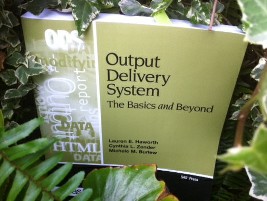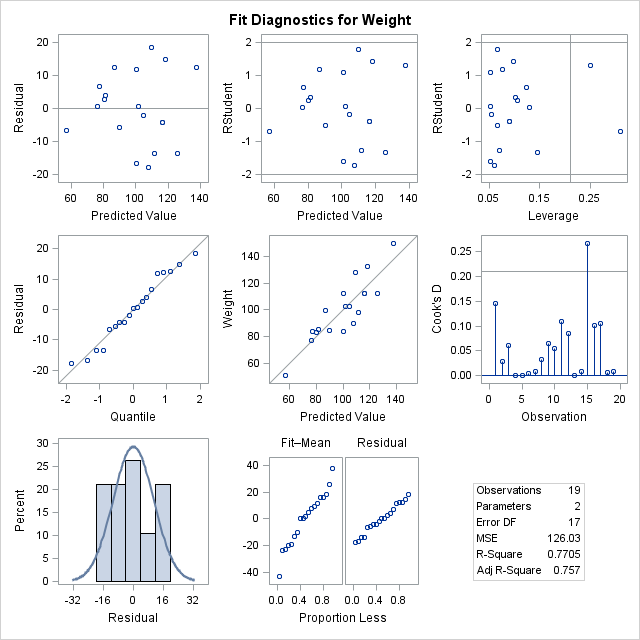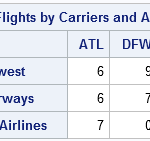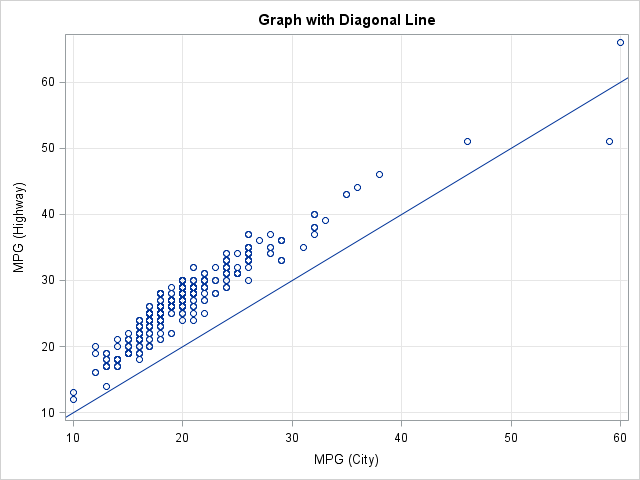
There are many things that I enjoy in life, but cooking and analytics are two of the things that excite me the most. In my free time, one of my favorite things to do is experiment in the kitchen to try to come up with something new and different to

There are many things that I enjoy in life, but cooking and analytics are two of the things that excite me the most. In my free time, one of my favorite things to do is experiment in the kitchen to try to come up with something new and different to

This week’s featured SAS author’s tip comes from SAS user extraordinaire Ron Cody. Honestly, because Ron has written so many SAS books, I could probably feature a year’s worth of tips from his work alone. To find something useful in any of Ron’s books, one merely needs to let the
In order to support a SAS Server Architecture, administrators must know where all the log files from the various SAS Business Intelligence services are located. By default, each service that generates a log will create it within the services' own configuration folder structure. For example, the metadata server log is

This article describes the SAS/IML CHOOSE function: how it works, how it doesn't work, and how to use it to make your SAS/IML programs more compact. In particular, the CHOOSE function has a potential "gotcha!" that you need to understand if you want your program to perform as expected. What

In a business environment that is increasingly global and technological, many businesses are finding themselves subject to two significant challenges: If your product or service can be “made,” it can be copied and someone else can make it cheaper and/or better. Customers are becoming ever more knowledgeable about products, vendors

When I was at the Joint Statistical Meetings (JSM) last week, a SAS customer asked me whether it was possible to use the SGPLOT procedure to produce side-by-side bar charts. The answer is "yes" in SAS 9.3, thanks to the new GROUPDISPLAY= option on the VBAR and HBAR statements. For

At SAS, our marketing and R&D divisions work together with customers to develop software products. Droves of our developers attend SAS users group conferences to talk to customers, demo new technologies and get user feedback. We have three customer advisory boards who tell us how they’re using SAS products, what
Summer is moving along too fast this year. I haven’t read nearly as many books as I had planned but last week I finished Triptych by Karin Slaughter (a good read). After finishing the book I looked up the meaning of the word ‘triptych’ and the first definition was a
The SAS/IML language provides two functions for solving a nonsingular nxn linear system A*x = c: The INV function numerically computes the inverse matrix, A-1. You can use this to solve for x: Ainv = inv(A); x = Ainv*c;. The SOLVE function numerically computes the particular solution, x, for a
It's always important to remember your fundamentals. Sort of like a basketball player who practices lay-ups and free throws for hours on end, you need the fundamentals in the midst of the game. Having the skills or knowledge in the heat of the moment - when it counts - is

Rome was not built in a day. Similarly, high-performance analytics is a product of many cumulative architectural, computational and analytical advances. The ability to solve complex business problems by applying algorithms from multiple disciplines to increasingly large volumes of data of all types - both structured and unstructured - is
This morning I’m having flashbacks about tutus and ballet recitals, high school musicals, local pre-dawn television interviews, and live SAS Press webinars. However, this time the butterflies have mostly migrated, there are no fun costumes, and I’m going to be seated behind my desk. And, most importantly, I’m feeling confident

Agility. I've been giving a lot of thought to the term while here in San Diego for the TDWI World Conference. "Evolving Your Agile BI Environment" is the theme of this year's event and "agility" has definitely been embedded in the conversations I have had with customers the past few
Since SAS is known as an innovative company, I jumped at the chance to hear advice from five SAS leaders on how to be more innovative. The following tips come from a recent panel discussion at SAS titled, “What does innovation look like to you?” Innovation is about solving problems,

Update: While the SAS analogy still works, my calories-in/calories-out strategy didn't! But today I'm in the best health of my life by using food as medicine, a journey that began by working with a SAS registered dietitian nutritionist. Read this post for a window into my experience. I’m a data-entry

In preparation for TDWI San Diego, I was finalizing my schedule and checking out what some of my favorite TDWI instructors are up to for San Diego. I'll be blogging about my fave classes from these instructors all next week. This evening I caught up on Cindi Howson 's blog

In the SAS/IML language, the index creation operator (:) is used to construct a sequence of integer values. For example, the expression 1:7 creates a row vector with seven elements: 1, 2, ..., 7. It is important to know the precedence of matrix operators. When I was in grade school,

I bet that many of you reading our blog are familiar with accomplished SAS users and authors Lauren Haworth, Cynthia Zender, and Michele Burlew. Together, they form a powerful triumvirate of SAS experience. If you get a chance to pick up their book Output Delivery System: The Basics and Beyond
Each indicator added to the dashboard begins with the saved name of the indicator. Take the example below, I dragged the spark table indicator '02_Top_CustomerSAT' into the new dashboard. Of course the 02_Top_CustomerSAT name is not necessarily what my executives would like to see on their dashboard view. But I

I've previously discussed how to find the root of a univariate function. This article describes how to find the root (zero) of a function of several variables by using Newton's method. There have been many papers, books, and dissertations written on the topic of root-finding, so why am I blogging

Everyone within the health care community recognizes that the traditional ‘pay-and-chase’ model for fraud cost reduction has some serious limitations. Recovery of the lost funds is in some cases a mere single digit percentage point (with some exceptions – but not many) of the moneys paid. And the effort and

At the SAS/IML Support Community, a SAS/IML programmer recently asked how to find "the root of a complicated equation." That's a huge question, and many papers and books have been written on the topic of root-finding, also known as finding the zeros of a function. Everyone has favorite techniques for

One of the great innovations with SAS 9.3 is the focus on ODS statistical graphics. "Wait a minute," you're thinking, "weren't ODS graphics added in SAS 9.2?" Yes, that's true. But with SAS 9.3 there is even more capability: more analytical SAS procedures support the graphs, and there are more

SIFMA held its Dodd-Frank Impact Analysis Summit in New York City on July 13, bringing together almost 500 industry participants for a day-long discussion just prior to the first anniversary of the Act’s passage. In addition to Tim Ryan (SIFMA CEO), the summit included guest speakers Larry Kudlow, Evan Thomas
Within BI Dashboard 4.3, you can change the font styles on different elements within the Dashboard. This is a global change to all the indicators displayed on the dashboard as you are unable to modify at an indicator level fonts for titles, cells, etc. Ranges are placed on indicators and

Recently, I was able to spend a morning with a group of analytics executives at the SAS Power Series in Chicago. I enjoyed it a lot because instead of pontificating about analytics to them, I got to hear about their challenges and approaches in a workshop format. There were a

A matrix is an array of numbers or character strings. When I print a matrix, I usually want to see only the data. However, sometimes it is helpful to add row or column headings that indicate the names of variables or labels for rows. A simple example is count data

In a previous blog post, I showed how to use the LOGISTIC procedure to construct a receiver operator characteristic (ROC) curve in SAS. That same day, Charlie H. blogged about how to use the DATA step to construct an ROC curve from basic principles. It has been a long time

I've written about how to add a diagonal line to a scatter plot by using the SGPLOT procedure in SAS 9.2. The main idea (use the VECTOR statement) is easy enough, but writing a program that handles a line with any slope requires some additional effort. But now SAS 9.3
contributed by SAS Publishing's Shelly Goodin For me, SAS Global Forum wouldn't be the same without getting a chance to catch up with SAS Press author Phil Holland. Besides being extremely knowledgeable about SAS (he's been using it since 1981), he is as enterprising and approachable as his popular book